Speech Economic Developments

Ric Battellino
Deputy Governor
Address to Committee for Economic Development of Australia (Western Australia)
Perth –
- Audio 16.72MB
- PDF version
Introduction
After having held official interest rates steady for five months, the Reserve Bank earlier this month tightened monetary policy a little further. The background to that decision and the reasons for it are set out in the quarterly Statement on Monetary Policy and the monetary policy minutes of the Board meeting that have subsequently been released. My talk today will focus on that material and outline some of the issues that are likely to shape economic developments over the next few years.
Global Economy
I will start with the global economy because, as always, this forms an important backdrop to understanding developments here in Australia.
The world economy is quite divided at present. The United States, Europe and Japan are struggling to recover from the effects of the financial crisis, while emerging Asian economies, and to a lesser extent Latin America, are growing strongly (Graph 1).
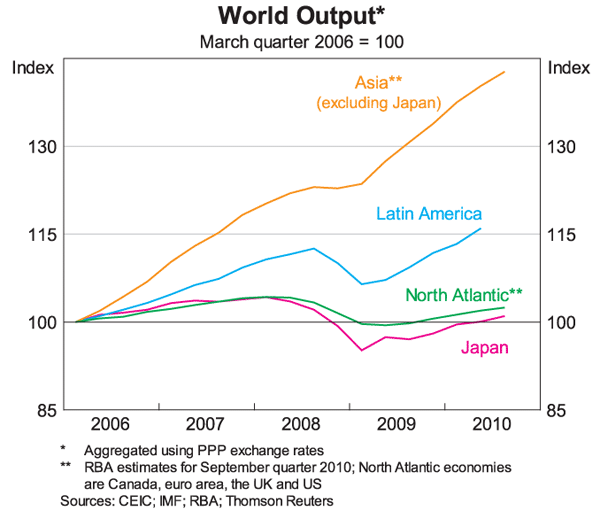
The US economy clearly lost momentum around the middle of the year, with GDP growth slowing to an annual rate of about 2 per cent over the June and September quarters. This is below potential. Our reading of more recent data is that they have been a bit stronger, but nonetheless consumer confidence remains low, the housing and labour markets remain weak, and the repair of household balance sheets still has quite a way to run.
Basically, the US household sector is in very poor shape.
One of the features of the US economy that has changed over the past 50 years or so is that households are now bearing more of the brunt of recessions than used to be the case, and businesses are bearing less. After each downturn, it has taken progressively longer for employment to regain its peak (Graph 2).
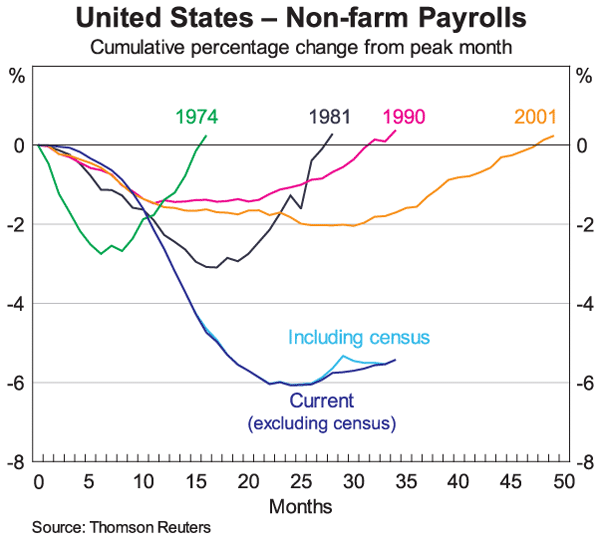
Even after the 2001 downturn, which was relatively mild in terms of GDP, it took about four years for employment to recover to its earlier peak. The current downturn has been much more severe, with employment falling by 6 per cent from peak to trough and the recovery in jobs so far being quite tepid. It is therefore clearly going to be some time yet before employment regains its pre-crisis levels.
Weak labour market outcomes, of course, mean subdued growth in household income, and the combination of job losses and low income growth has led to a big rise in mortgage foreclosures. Almost one in twenty houses that are mortgaged in the United States is in foreclosure. This is a very high figure (Graph 3).
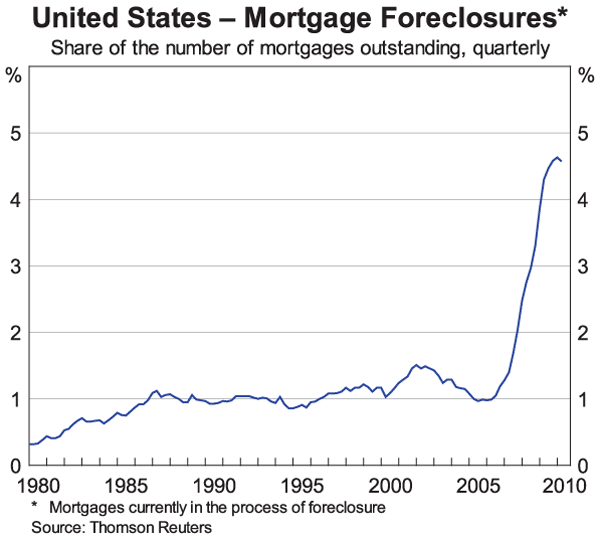
Household wealth has fallen sharply. Measured relative to household income, it is back to the levels of the late 1980s, so a large amount of wealth has been wiped out (Graph 4).
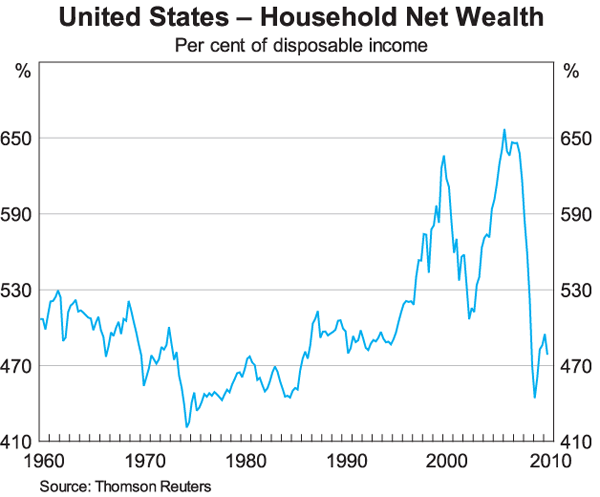
At the same time, household gearing has risen sharply, with housing debt now equal to about 55 per cent of the value of the US housing stock.
Understandably, the reaction of households to all this has been to stop borrowing, cut back on spending and increase savings, all of which means that US households are not going to be the driving force of the global economy that they were for much of the period since the mid 1990s.
The US corporate sector, on the other hand, is in pretty good shape.
Profits have recovered strongly and the arrears rate on loans to US corporates has peaked at a level that is quite moderate by historical standards; it is no higher than in the 2001 recession, which, as I have noted, was quite mild (Graphs 5 and 6).
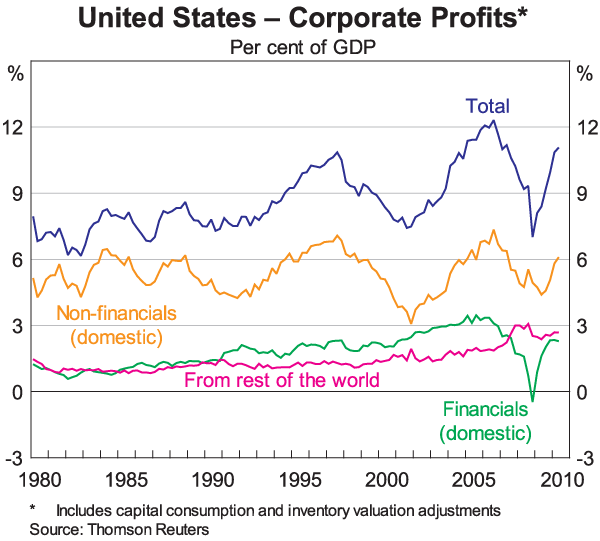
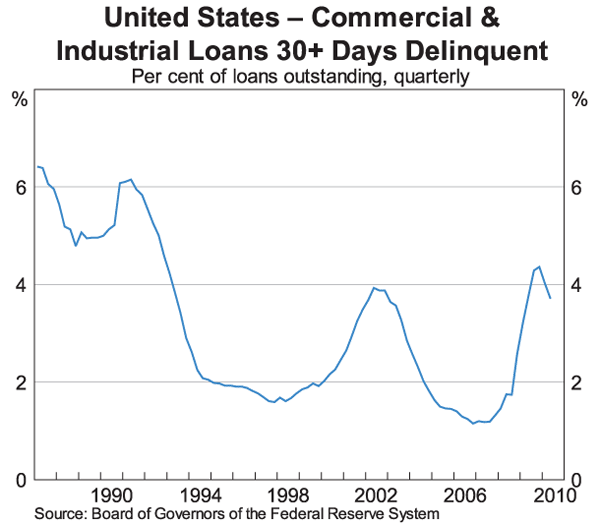
Also, holdings of cash by US corporations are at record levels – almost US$1½ trillion or equivalent to over 20 per cent of corporate debt (Graph 7). This means that US corporations are in a strong position to increase investment when confidence returns.
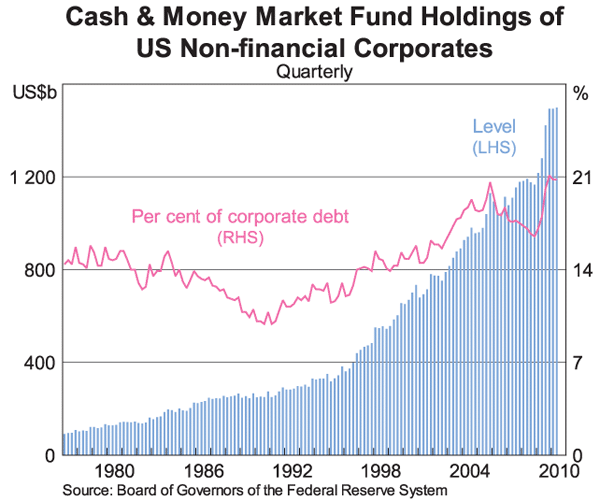
The US Federal Reserve has been maintaining official interest rates close to zero since late 2008 but, despite this, the economy has remained sluggish. The Fed has therefore tried to use other instruments to stimulate economic activity.
These measures generally fall under the heading of ‘quantitative easing’. They involve expanding the Fed's balance sheet through the purchase of securities, with payment for those securities being made by giving banks extra deposits at the Fed. The Fed has roughly tripled the size of its balance sheet since the financial crisis began, to over US$2,000 billion. Earlier this month, it foreshadowed it would be prepared to purchase another US$600 billion of Treasury securities by next June, if circumstances warranted it (Graph 8).
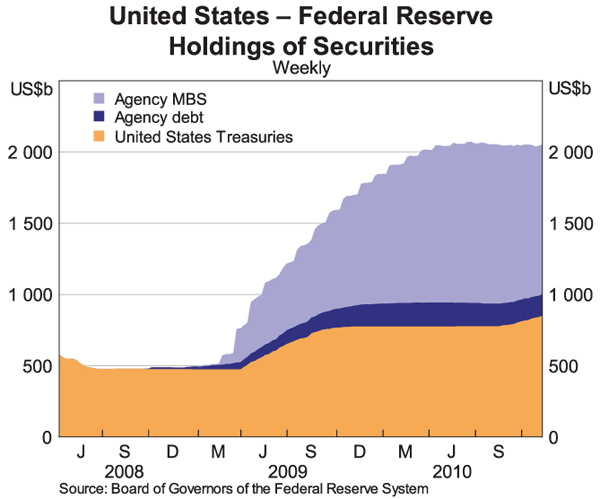
The objectives of these operations are to put downward pressure on market interest rates, so as to encourage households and businesses to borrow, and to provide banks with extra liquidity, so as to encourage them to lend. As noted, however, US households have little appetite for debt at present, US corporations are flush with cash and have little need to borrow, and banks appear to be quite happy to leave their extra liquidity on deposit at the Fed, rather than lend it. US banks are currently holding about 8 per cent of their assets on deposit with the Fed, while their loans to households and businesses are falling (Graph 9).
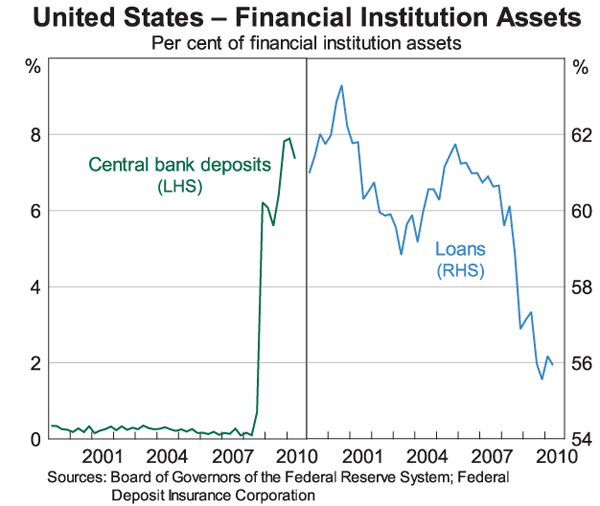
These outcomes are typical of what happens in the wake of a financial crisis, as it takes a long time for households, businesses and banks to repair the damage done to their balance sheets and regain confidence to borrow or lend again. This often means a prolonged period of sub-par growth.
In Europe, growth on average has been around trend over the past year, but there is a wide divergence in the performance of countries. Germany is doing well, benefiting from earlier economic reforms and Chinese demand for German capital goods, but, at the other extreme, Greece and Ireland are experiencing very deep recessions. Economic tensions have been building within the euro area, driven by earlier widening differentials in competitiveness. Unit labour costs in Greece, for example, have risen by about 25 per cent relative to those in Germany since the euro came into existence.
Government debt problems are also probably at their most acute in Europe. The facility set up by European governments in May this year to provide financing to smaller European countries seemed for a time to lessen market concerns about sovereign debt levels. However, the situation has deteriorated noticeably again in recent weeks, as markets again question the capacity of some countries to sustain their current debt levels.
On the other hand, as I mentioned, Asia is a bright spot in the global economy. The region bounced back very strongly from the global financial crisis and economic activity in all emerging Asian economies has substantially surpassed pre-crisis levels. Several central banks in the region have recently been tightening policy settings, but generally policy settings in Asia are still quite expansionary. Some commentators are concerned that the recent tightening might lead to excessive slowing in economic growth, particularly in China, but this seems unlikely while ever policy settings are still on the expansionary side. In fact, economic activity in China recently appears to have picked up again.
Inflation could become a significant policy issue in Asia if growth remains strong. There are already early signs of rising inflationary pressures, particularly in food prices. Some Asian economies are also experiencing very strong rises in house prices, reflecting the favourable economic and financial climate (Graph 10).
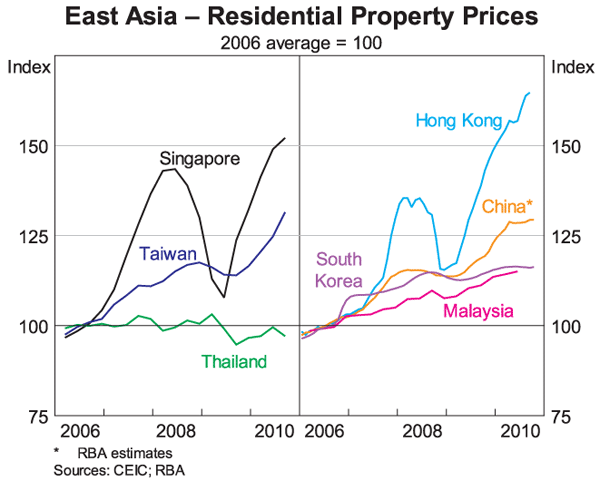
Overall, the outcome for global economic growth over the past year has been strong. When the figures for 2010 come in, they are likely to show that the world economy grew by around 4¾ per cent, a rate that is noticeably above trend (Graph 11). Most forecasters are expecting that the growth of the global economy over the next couple of years will be slower than in 2010, though probably at a pace that is close to trend.
There are, of course, risks to these outcomes arising from some of the issues I have mentioned. In the developed economies, the concerns are mainly about downside risks. What is worrying people is that the capacity of the authorities in most developed economies to deal with any renewed economic slowdown would be limited, due to the fact that policy settings are already at extremes. In Asia, on the other hand, it is easier to see risks of overheating.
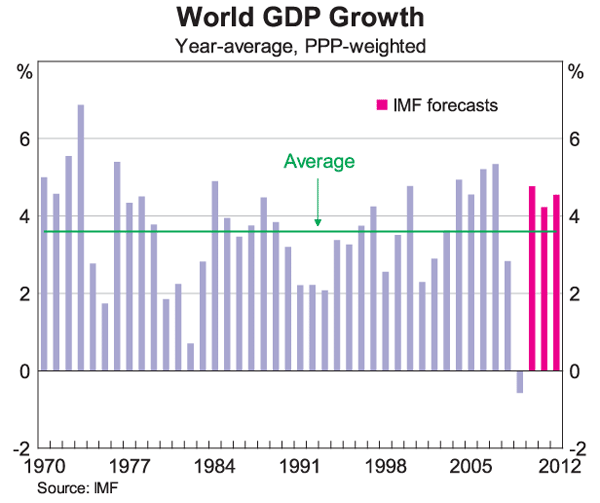
Commodity Prices
The growth of the world economy that has occurred over the past year has resulted in a significant lift in the prices of commodities. The prices of the two commodities of most importance to Australia – iron ore and coal – have been especially strong, and have again risen in recent weeks (Graph 12).
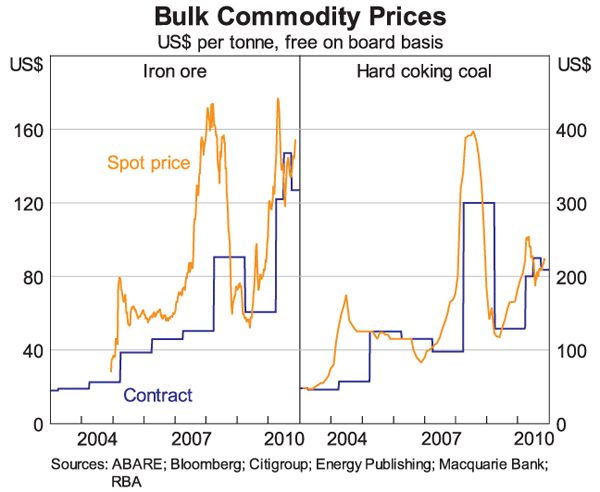
As a consequence, Australia's terms of trade – the ratio of export prices to import prices – have surpassed the 2008 peak, and are pretty much at unparalleled levels. The increase in the terms of trade over the past year has added around $25 billion to the Australian economy.
The question is: how long will this last? At the Reserve Bank, we have for some time been forecasting a gradual decline in the terms of trade over the next couple of years, on the assumption that the supply of commodities will increase and that demand will slow a little, in line with the assumed slowing in the global economy. This continues to be our projection, though recent commodity price outcomes have caused us to revise up our forecasts.
Beyond the next couple of years, it is hard to predict what will happen. Both China and India, however, are going through a phase of their development that is very intensive in the use of steel. In the past, other countries have taken up to 20 years to move through this phase (Graph 13). It is likely that China, and more particularly India, will have strong demand for steel for quite some time yet.
This, of course, would be a very favourable global environment for the Australian economy.
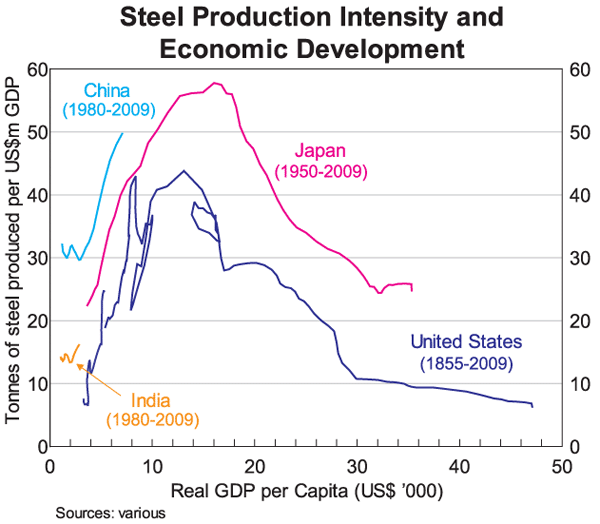
The Australian Economy
Let me now turn to the Australian economy.
As you know, our economy recovered relatively quickly from what was a shallow downturn following the global financial crisis, and over the past year has grown around its trend rate of 3¼ per cent (Graph 14).
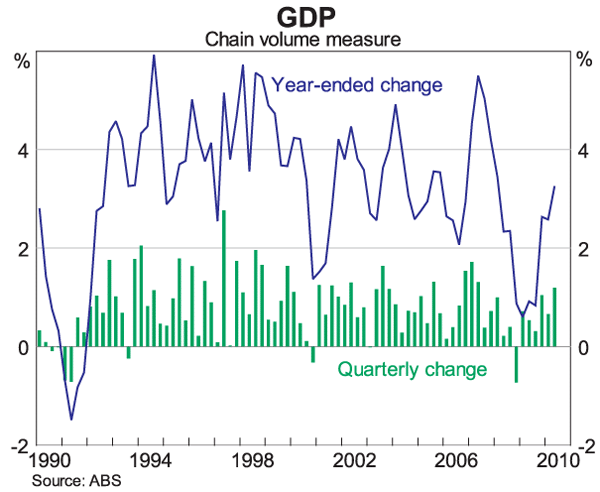
Domestic demand has grown substantially faster than this – about 5¼ per cent – due importantly to growth in public spending, though this is moderating now.
Consumer spending has grown by a little below trend over the past year. It seems that even though consumer confidence is high, consumers remain cautious in their spending. The household saving ratio has picked up noticeably from the low levels it fell to earlier this decade. As we have said before, a period of consolidation by Australian households, after 10–15 years of fairly robust increases in spending and gearing, is probably no bad thing.
Investment in new dwellings has increased over the past year, though growth in the number of dwellings is still falling short of growth of the population. As a result, rental markets are tightening, with vacancy rates falling and rents rising at a solid pace. At the same time, however, households now seem to be less inclined to increase their gearing in order to trade up to better housing. Auction clearance rates have fallen back to around long-run average levels and house prices have been relatively flat over recent months (Graph 15). This is in keeping with the more financially conservative approach that Australian households have taken recently. These trends are probably most pronounced here in Perth, which is going through a period of adjustment after the euphoria of 2006 and 2007.
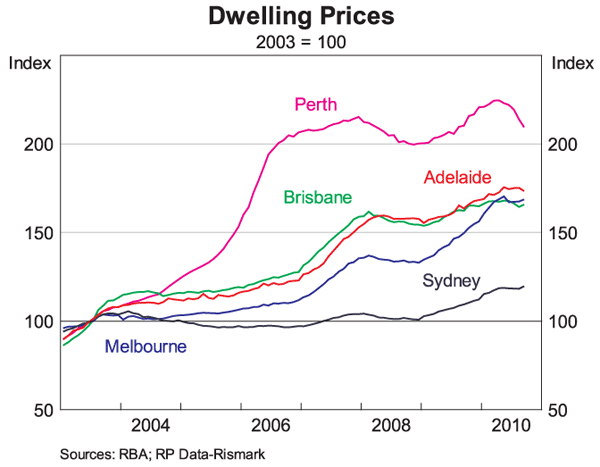
Business conditions are generally around average levels, although there are clear differences across sectors. Business investment is at a high level, particularly in the mining sector, and information published by the Australian Bureau of Statistics, as well as our own liaison with companies, suggest that it will pick up sharply further over the next couple of years (Graph 16). In this regard, I would like to acknowledge the vital role played by our office here in Perth, led by Virginia Christie, in helping us understand what is going on in the mining industry. And, of course, I would like to thank those many businesses that regularly make time available to talk to Virginia and her team.
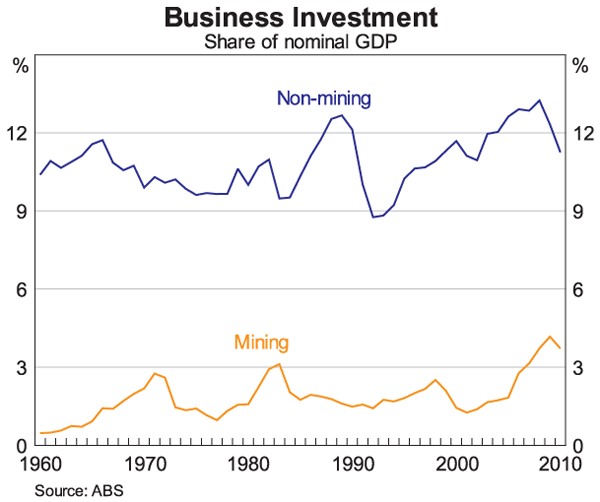
One segment of business investment that remains weak, however, is non-residential building. Following large increases in gearing and commercial property prices in 2006 and 2007, the commercial property market has since deleveraged and prices have fallen. The bulk of that adjustment is probably now over, though the availability of finance for commercial property development remains very tight.
Employment has grown strongly over the past year and the unemployment rate has fallen back to a range of 5–5½ per cent, which historically has indicated a degree of tightness in the labour market. Other indicators, however, suggest that the overall labour market may not be as tight as suggested by the unemployment rate.
The financial side of the economy remains subdued. Household credit is growing at a moderate pace while business credit remains soft. That softness is largely in relation to large borrowers; lending to small businesses has increased at an annual rate of about 5 per cent over the first nine months of 2010 (Graph 17).
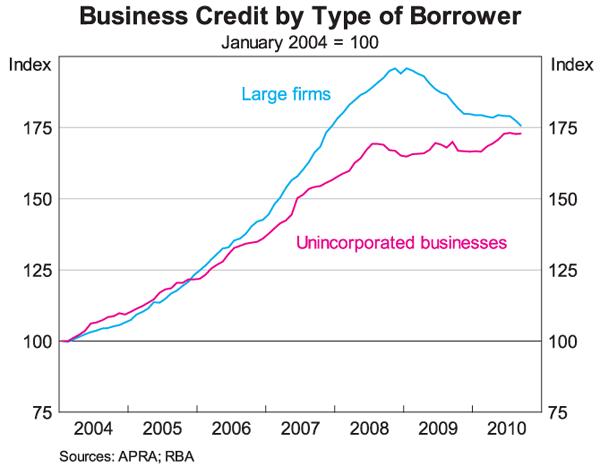
We have spent a fair amount of time at the Bank looking at the question of why business credit is so soft. It is clear that banks had tightened lending standards sharply following the onset of the global financial crisis, which no doubt contributed to the slowdown in business lending. This has been most acute in the area of commercial property, where there has been a sharp cutting back, particularly by foreign-owned banks.
More recently, there are signs that banks are becoming more willing to lend, at least in areas other than commercial property, but demand for loans, in aggregate, is not very strong. It seems that the investment that is taking place in Australia, particularly in the case of the mining sector, is largely being financed outside the banking sector, either from retained earnings, direct investment from overseas or capital market raisings.
The exchange rate is also clearly having an impact on business conditions. It has risen to post-float highs recently, although the real effective exchange rate remains below the levels recorded in the resources boom of the early 1970s (Graph 18).
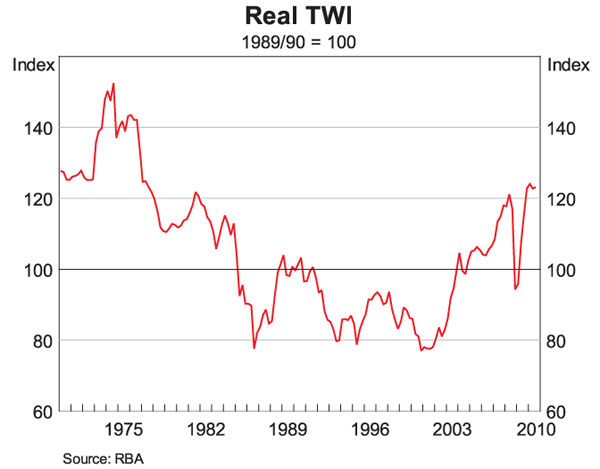
A rise in the exchange rate is a natural consequence of a resources boom and, at the aggregate level, is helpful in allowing the economy to adjust. Nonetheless, some sectors of the economy are adversely affected. A notable example at present is the tourism industry, where there has been a sharp increase in the number of Australians travelling abroad rather than taking holidays domestically. This is having a severe effect on traditional holiday destinations in Queensland, areas which are also suffering from overbuilding in the pre-crisis years. Given this double impact, it is not surprising that these areas are currently experiencing among the highest rates of unemployment in the country. The Bank is monitoring developments in these areas closely.
The Outlook
While there are differences between sectors and between regions, the Australian economy overall is doing well. We expect that the economy will continue to grow at a solid pace over the next couple of years, with growth picking up to an above-trend rate towards the end of this period. This will be accompanied by further increases in jobs and falls in unemployment.
With the economy now having grown more or less without interruption for about 20 years, it is understandable that spare capacity is limited. This means that the economy cannot grow much above its potential rate without causing a rise in inflation. With a large amount of money continuing to flow into the country over the next couple of years as a result of the resources boom, the challenge will be to manage the economy in a way that keeps economic growth on a sustainable path, with inflation contained. This is what the Bank is trying to do.
At present, inflation is broadly in the middle of the target range (Graph 19). Over the medium term, though, as growth of the economy picks up, the pressures on inflation are more likely to be upward than downward. This is reflected in the forecasts the Bank recently published, which see inflation tending to rise after a period of near-term stability.
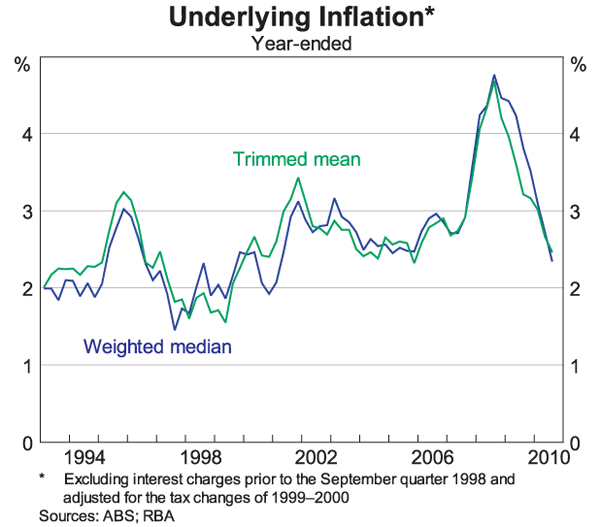
For this reason, the Board of the Reserve Bank decided at its meeting earlier this month that it would be prudent to make an early, modest tightening to guard against such an outcome. This is consistent with the forward-looking approach to monetary policy that the Bank has been following for close to 20 years now, and which on balance has helped to keep the economy on a sustainable path.